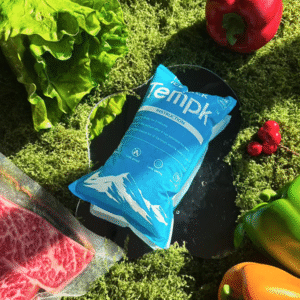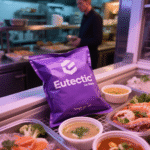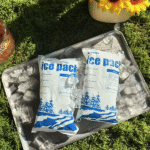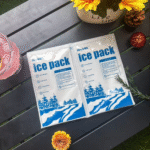Insulated Dry Ice Pack Sheet: What Should You Use?
Si vous expédiez des marchandises surgelées, un insulated dry ice pack feuille helps you hold −78.5°C longer, cut sublimation loss, and pass audits. You’ll learn how to size an insulated dry ice pack sheet for 24–72‑hour lanes, pack to IATA PI 954/UN1845 rules, and choose materials that actually lower claims. Dry ice sits at −78.5°C; mis‑packing raises risk and cost.
-
Pick the right insulated dry ice pack sheet pour la nourriture, biologique, ou réactifs de laboratoire (long‑haul frozen shipping).
-
Calculer la quantité de glace carbonique using a quick planning method (5–10 lb par 24 h as a baseline).
-
Pack safely and compliantly (Marque de l'UN1845, Classe 9 étiquette, ventilation, 2.5 kg passenger limits, PI 954).
-
Reduce claims by pairing your insulated dry ice pack sheet with better liners (VIP vs. bubble vs. PSE).
What is an insulated dry ice pack sheet, and when should you use it?
Un insulated dry ice pack sheet is a flexible, cut‑to‑fit pad that lines products or voids to slow heat gain and dry ice loss. It wraps around items, adding a thin thermal barrier so your dry ice works longer without adding bulk or weight. Use it when you need −78.5°C stability through sort centers, door swings, or delays.
En termes simples: dry ice keeps things frozen; the insulated dry ice pack sheet helps the dry ice keep c'est cool. It’s like a scarf around a thermos—less heat sneaks in, so less CO₂ “evaporates.” Choose it for frozen meats, glace, tissue samples, or lane trials that push past 24 heures.
How does an insulated dry ice pack sheet compare to liners?
The insulated dry ice pack sheet is a local, product‑hugging layer; a box liner (PSE, reflective bubble, ou vip) lines the entire shipper. Bubble wraps typically deliver ~R‑1 per 3/8″ without sealed air spaces; VIP panels deliver far higher R‑values per inch. Use both when lanes are long or ambient heat is high.
| Choix d'isolation | Typical build | R‑value signal | Ce que cela signifie pour vous |
|---|---|---|---|
| Reflective bubble | Déjouer + bubbles | Often ~R‑1 per 3/8″ unless air space is perfect | Fine for short hops; don’t expect miracles in summer. |
| EPS foam liner | Molded foam | ~R‑3.5 to R‑4.2 per inch | Cost‑effective baseline for day‑definite deliveries. |
| VIP liner | Vacuum panel | ~R‑25 to R‑50 per inch reported | Maximizes runtime; slim walls protect payload volume. |
Conseils pratiques & conseil
-
For 24–48 h lanes: pair an insulated dry ice pack sheet with EPS.
-
For 48–72 h lanes or hot routes: add VIP lid/walls plus the insulated dry ice pack sheet near the product core.
-
For laboratory vials: wrap vials with the insulated dry ice pack sheet, then backfill voids with dry ice nuggets.
Cas réel: A frozen dessert shipper added one insulated dry ice pack sheet around pint clusters and swapped to VIP lid only. Sublimation fell by “about a third” on a 48 h lane, cutting replacement dry ice by ~6 lb per box and halving melt complaints.
How do you size an insulated dry ice pack sheet pendant 24 à 72 heures?
Réponse courte: commencer par 5–10 lb de glace sèche par 24 heures in a well‑insulated cooler, then trim or add based on ambient, cube, and liner R‑value. An insulated dry ice pack sheet reduces the required margin because it slows product‑side heat leak.
Why that range works: Dry ice sublimates faster with warm air, repeated openings, and low‑R packaging. UPS and multiple industry sources cite 5–10 lb per day as practical guidance; better insulation pushes you to the lower end.
A 2‑minute planning method (copy‑and‑use)
-
Pick a baseline: 7 lb/24 h.
-
Adjust for insulation:
-
Bubble/EPS only: +20%
-
PSE + insulated dry ice pack sheet: 0%
-
VIP + insulated dry ice pack sheet: −20%
-
-
Adjust for ambient:
-
Cool (≤20°C): −10%
-
Chaud (30–35°C): +25%
-
Very hot (≥35°C): +40%
-
-
Multiply by days (include buffers for weekends/weather).
-
Round up to nearest 1 lb or 0.5 kg.
Exemple: 48 h route, PSE + insulated dry ice pack sheet, hot 33°C.
7 lb × (1.00) × (1.25) × 2 = 17.5 kg → round to 18 kg glace carbonique.
Conseil: A tighter product wrap with the insulated dry ice pack sheet can drop your starting point toward 5 lb/24 h in good liners. Verify with a lane qualification test.
How do you pack with an insulated dry ice pack sheet sans risque (Voici pi 954 / UN1845)?
The essentials: marque «Glace sèche» ou «dioxyde de carbone, solide,” plus UN1845 et poids de glace sec nette (kg) des deux côtés; apply a Classe 9 étiquette de danger; utiliser emballage ventilé; and keep the package ≤200 kg dry ice per piece for air cargo. For passengers, the limit is 2.5 kg per person avec approbation des compagnies aériennes.
Packing steps (simplified):
-
Pré-Chill à l'expéditeur; load product wrapped in the insulated dry ice pack sheet.
-
Add a vent path (Jamais hermétique); dry ice must vent CO₂ gas.
-
Place dry ice around and on top of the wrapped product to create a cold dome.
-
Fermer, étiquette, and document (UN1845; net dry ice kg; Classe 9). Bagages de passagers: 2.5 limite de kg, marked and vented.
Pourquoi la ventilation est importante: CO₂ gas displaces oxygen; OSHA’s TWA limit is 5,000 ppm, alors que 40,000 ppm is an IDLH level. Keep areas ventilated and consider CO₂ monitoring where you stage multiple boxes.
Will an insulated dry ice pack sheet reduce sublimation costs?
Yes—by reducing heat leak at the product interface, an insulated dry ice pack sheet can push you toward the lower end of the 5–10 lb/24 h consumption band. In real lanes, that often removes 2–6 lb per box and frees payload space for revenue.
Sublimation isn’t “waste”—it’s the cooling engine. But if heat reaches product surfaces too easily, dry ice burns down faster. By adding a targeted layer, the insulated dry ice pack sheet lowers peak heat flux during the first hours (when products are warmest) and during handoffs. You’ll still qualify each lane, but the sheet is a low‑cost lever before you jump to VIP.
Quick A/B test plan you can run this week
-
UN (contrôle): EPS liner + dry ice only.
-
B (test): Same loadout + insulated dry ice pack sheet around payload.
-
Enregistrer: Dry ice start/end weights, product core temps, ambient profile.
-
Win condition: ≥15% less dry ice consumed with equal or better product temps.
Actual example: A vaccine courier added an insulated dry ice pack sheet and switched dry ice from pellets to blocks + top‑off pellets. Runtime improved by ~12 hours; CO₂ monitor alarms stopped triggering in the staging room due to fewer lid lifts. (Keep CO₂ within OSHA 5,000 ppm twa; IDLH is 40,000 ppm.)
Material choices for your insulated dry ice pack sheet: What works in 2025?
Reflective bubble sheets are thin and cheap but deliver modest R‑values unless paired with sealed air spaces. Panneaux VIP deliver unmatched R‑per‑inch, helping you downshift dry ice mass. Hybrid builds place an insulated dry ice pack sheet around the product and use EPS walls plus a VIP lid to control budget.
Starter decision guide (rapide)
-
Small parcel, 24–48 h, chaleur modérée: EPS walls + insulated dry ice pack sheet (product wrap).
-
48–72 h or hot lanes: EPS walls + VIP lid + insulated dry ice pack sheet.
-
High‑value biologics: Full VIP set + insulated dry ice pack sheet + data logging.
Safety notes you can actually use
Souviens-toi: dry ice is −78.5°C and can cause frostbite; never seal it airtight; label correctly; ventilate staging areas; monitor CO₂ if you stage pallet quantities. For air cargo, ≤200 kg per package Sous pi 954 with correct marks/labels; for passengers, ≤ 2,5 kg per person with airline approval and venting.
One‑line checklist: “UN1845 + ‘Dry Ice/Carbon Dioxide, solid’ + Kg net + Classe 9 + ventilation + no sealed tubs.”
Troubleshooting shipments with an insulated dry ice pack sheet
Problème: product temp rose near delivery.
Fix: Add top‑load dry ice and keep the insulated dry ice pack sheet snug against product faces (minimize voids).
Problème: courier rejected due to labels.
Fix: Print UN1845, Classe 9, and net kg on two sides; ensure the sheet and box don’t obstruct labels.
Problème: CO₂ alarm in staging.
Fix: Increase ventilation; stage fewer boxes; minimize lid‑open time; keep OSHA 5,000 ppm TWA in mind; IDLH is 40,000 ppm.
2025 regulatory and market updates that impact your choice
Traçabilité & inspections: FDA’s FSMA 204 traceability rule still shows a Jan 20, 2026 compliance date in the final rule, but in Aug 2025 the FDA proposed un 30‑month extension to July 20, 2028; routine inspections won’t start until 2027. Plan records and labels now, even if enforcement phases in later.
Air rules: IATA’s current materials reaffirm PI 954 exigences (marquage, ventilation, ≤200 kg per package for air cargo). For passengers, 2.5 kg per person with airline approval and marks remains the norm.
Supply/demand context: Dry ice demand remains strong; market analyses point to continued growth, while CO₂ sourcing sees regional constraints and new capture projects (RNG, industrial). Expect spot price swings; build margin in your load plans.
Derniers développements en un coup d'œil
-
FSMA 204 timeline: Proposed extension to Juillet 20, 2028 pour la conformité; routine inspections in 2027. Ce que cela signifie: more time to digitize traceability without pausing packaging upgrades.
-
PI 954 liste de contrôle d'acceptation (2026): Clear call‑outs for UN1845 marks, ≤200 kg par forfait, et ventilation. Ce que cela signifie: build standard work around a single page.
-
High‑performance liners: VIP R‑values per inch help cut dry ice mass while preserving payload volume. Ce que cela signifie: pair VIP lid/panels with your insulated dry ice pack sheet for 48–72 h lanes.
Perspicacité du marché: PCMS (Matériaux à changement de phase) keep gaining traction for refrigerated (+2 to +8°C) voies; pour congelé lanes you’ll still rely on dry ice, but hybrid boxes (PCM pre‑cool + dry ice kick) smooth temperature curves and reduce fogging.
Interactive chooser: do you need an insulated dry ice pack sheet?
-
If your lane ≥ 36 heures ou ambient ≥ 30°C → Use it.
-
If you’ve had frost‑burn or cold spot damage → Use it to buffer product faces.
-
If claims come from late stops → Add a sheet + glace sèche à chargement supérieur.
-
If payload volume is tight → Use sheet + VIP lid instead of thicker foam.
Comment emballer (Howto) avec un insulated dry ice pack sheet
-
Condition the shipper and product to freezer temps.
-
Envelopper the payload snugly with the insulated dry ice pack sheet; tape edges if needed.
-
Lieu dry ice blocks below and pellets above to form a cold canopy.
-
Secouer: Jamais hermétique.
-
Marque & étiquette: UN1845, Nom d'expédition approprié, Kg net, Classe 9.
-
Document on air waybill (count × net kg).
FAQ
Q1: Combien insulated dry ice pack sheet layers do I need?
Commencer par one layer directly touching the product faces. For long lanes or hot routes, add a second layer on the lid side where heat enters fastest.
Q2: How much dry ice per day?
Planifier 5–10 lb par 24 h in well‑insulated shippers; your insulated dry ice pack sheet helps you lean toward the low end. Test and document.
Q3: Is passenger baggage allowed with dry ice?
Oui-2.5 kg (5.5 kg) par passager, vented and properly marked; airline approval is required.
Q4: Do I still need a Class 9 label and UN1845 text?
Yes—mark «Glace sèche» ou «dioxyde de carbone, solide,»Un1845, et Kg net sur le paquet, et appliquer un Classe 9 étiquette.
Q5: Is bubble wrap enough insulation?
Often not by itself; typical effective R‑values are low without sealed air gaps. Combine it with EPS or VIP and an insulated dry ice pack sheet around the product.
Q6: What about CO₂ safety limits?
Follow OSHA 5,000 ppm twa and note IDLH 40,000 ppm. Ventilate staging rooms and avoid airtight boxes.
Résumé & recommandations
Principaux à retenir: Utilisez un insulated dry ice pack sheet to cut heat leak at the product, which lowers dry ice consumption toward 5–10 lb/24 h. Pack and label to UN1845 + Classe 9, vent for safety, and use VIP/EPS liners as the route demands. Size with a simple model, then verify in lane tests.
Étapes suivantes (Faites ça maintenant):
-
Qualify one lane with/without an insulated dry ice pack sheet.
-
Standardiser PI‑954 marks and venting across pack‑outs.
-
Right‑size isolation: add a VIP lid if routes exceed 48 h.
-
Moniteur CO₂ in staging zones and keep records for FSMA/quality.
À propos du tempk
We are a cold‑chain packaging team focused on reliable frozen performance with fewer moving parts. Our insulated dry ice pack sheet is engineered to hug product faces, reduce early heat spikes, and simplify IATA/UN labeling workflows. We back pilots with data logging templates and right‑sizing advice so you can hit temperature targets while lowering total cube and cost.
Appel à l'action: Ready to qualify your lane? Start a quick pilot with our insulated dry ice pack sheet and a sizing plan tailored to your route.
























